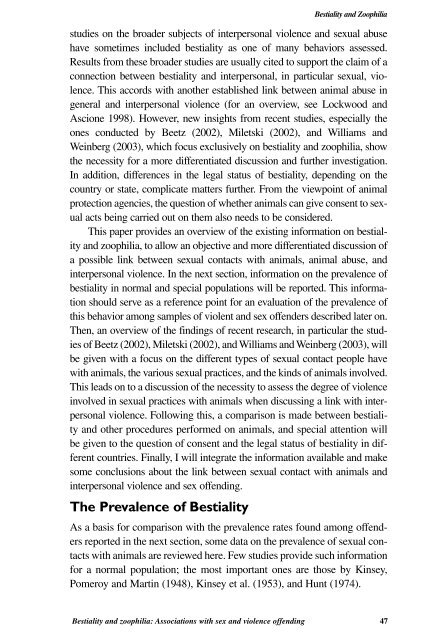Bestiality and zoophilia - Evolve For Animals
Bestiality and zoophilia - Evolve For Animals
Bestiality and zoophilia - Evolve For Animals
You also want an ePaper? Increase the reach of your titles
YUMPU automatically turns print PDFs into web optimized ePapers that Google loves.
<strong>Bestiality</strong> <strong>and</strong> Zoophiliastudies on the broader subjects of interpersonal violence <strong>and</strong> sexual abusehave sometimes included bestiality as one of many behaviors assessed.Results from these broader studies are usually cited to support the claim of aconnection between bestiality <strong>and</strong> interpersonal, in particular sexual, violence.This accords with another established link between animal abuse ingeneral <strong>and</strong> interpersonal violence (for an overview, see Lockwood <strong>and</strong>Ascione 1998). However, new insights from recent studies, especially theones conducted by Beetz (2002), Miletski (2002), <strong>and</strong> Williams <strong>and</strong>Weinberg (2003), which focus exclusively on bestiality <strong>and</strong> <strong>zoophilia</strong>, showthe necessity for a more differentiated discussion <strong>and</strong> further investigation.In addition, differences in the legal status of bestiality, depending on thecountry or state, complicate matters further. From the viewpoint of animalprotection agencies, the question of whether animals can give consent to sexualacts being carried out on them also needs to be considered.This paper provides an overview of the existing information on bestiality<strong>and</strong> <strong>zoophilia</strong>, to allow an objective <strong>and</strong> more differentiated discussion ofa possible link between sexual contacts with animals, animal abuse, <strong>and</strong>interpersonal violence. In the next section, information on the prevalence ofbestiality in normal <strong>and</strong> special populations will be reported. This informationshould serve as a reference point for an evaluation of the prevalence ofthis behavior among samples of violent <strong>and</strong> sex offenders described later on.Then, an overview of the findings of recent research, in particular the studiesof Beetz (2002), Miletski (2002), <strong>and</strong> Williams <strong>and</strong> Weinberg (2003), willbe given with a focus on the different types of sexual contact people havewith animals, the various sexual practices, <strong>and</strong> the kinds of animals involved.This leads on to a discussion of the necessity to assess the degree of violenceinvolved in sexual practices with animals when discussing a link with interpersonalviolence. Following this, a comparison is made between bestiality<strong>and</strong> other procedures performed on animals, <strong>and</strong> special attention willbe given to the question of consent <strong>and</strong> the legal status of bestiality in differentcountries. Finally, I will integrate the information available <strong>and</strong> makesome conclusions about the link between sexual contact with animals <strong>and</strong>interpersonal violence <strong>and</strong> sex offending.The Prevalence of <strong>Bestiality</strong>As a basis for comparison with the prevalence rates found among offendersreported in the next section, some data on the prevalence of sexual contactswith animals are reviewed here. Few studies provide such informationfor a normal population; the most important ones are those by Kinsey,Pomeroy <strong>and</strong> Martin (1948), Kinsey et al. (1953), <strong>and</strong> Hunt (1974).<strong>Bestiality</strong> <strong>and</strong> <strong>zoophilia</strong>: Associations with sex <strong>and</strong> violence offending 47


